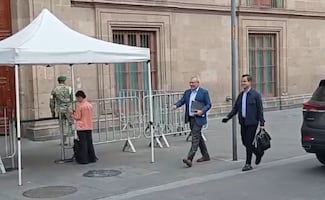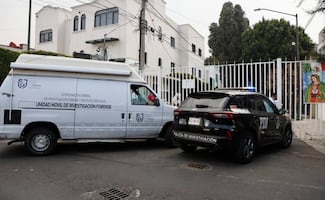Más Información

Senador del PT propone crear televisión, radio y periódico de la 4T; debemos hacer frente a medios de derecha, dice

César Duarte comparece ante jueza en penal del Altiplano; buscan vincularlo por presunto lavado de dinero

¿Qué es el Tratado de Aguas de 1944 entre México y EU por el que Trump amaga con imponer aranceles?; te explicamos

Gobernador de Michoacán se reúne con Sheinbaum en Palacio Nacional; acude también gabinete de Seguridad

Posponen en el Senado discusión y votación de reforma para crear la figura de “jueces sin rostro”; se discutirá en febrero

VIDEO Hallan a pareja sin vida en colonia Lindavista; una de las víctimas era abogado que litigó temas de despojos en Ecatepec
There is a treasure in the depths of the Hotel Posada de la Misión in Taxco . Yes: a mine full of gold, silver, and quartz , but especially culture, stories, legends, and myths . It is a mine that the Chontal , the natives of Taxco, exploited in the 1400s and that they closed so that the Spanish would not take advantage of it.
The mine was discovered in February 2013 while the owners of a bar that was in the lobby of the hotel were renovating it. The builders were digging to lower the floor of the bar because people hit their heads constantly with a beam.
While they dug, they found a cavity : it was a well that took them to an unknown depth.
Researchers
and geologists have calculated that this mine was barely exploited by a 2% by the Chontal.
The plan changed. The renovation of the bar was suspended, and the exploration of the well began. They went down and noticed there were paths . They understood they had found a mine. Then, they called engineers who were working for Grupo México to confirm the finding, but they detected several differences: there were mining works , but very superficial and rudimentary as if they had been done many years ago.
Later on, they reported it to Mexico’s National Institute of Anthropology and History (INAH) . The anthropologists who went to the mine first thought that it was from colonial times, but they confirmed later that the mine was 100% pre-Hispanic .
The call
Five years ago, Alfonso Martín Macotello was a mine rescuer. He worked in Iguala. In April 2014 , he received a call to offer him a job. He had to supervise and guide 35 workers digging in a recently discovered mine. He did not hesitate, moved to Taxco, and has not left since.
Now, Alfonso Martín is one of the main guides and has become one of the researchers of the pre-Hispanic mine. He explains that this mine is the only one of its kind in Guerrero and also the only in the country open to the public.
Currently, it is kept safe by Hotel Posada de la Misión, and is considered a cultural heritage by the INAH.
In the last five years, Alfonso Martín has got to know the mine by heart .
This mine started to become famous just 5 years ago, before that it was thought that the most ancient one was “El Socavón del Rey” mine, the first to be exploited by the Spanish in Taxco.
Alfonso Martín says that this mine was unknown because the Chontals kept it from the Spanish but there are signs that ancient inhabitants of Taxco worked on it in the 1400s and in the early 1500s .
The action of the Chontals allowed this pre-Hispanic mine to be full of minerals and stories nowadays.
Alfonso Martín tells how researchers, anthropologists, and geologists have left the mine amazed by its beauty . And it is true: “This pre-Hispanic mine is a beauty that conveys calmness, that vibrates differently from the surface.”
For instance, he remembers, when a teacher of the Earth Sciences College of the Autonomous University of Guerrero (Uagro) decided to do testings by himself inside the mine, he had amazing results: he found that for every ton of rock, there are 3 grams of gold, and 3 kilograms of silver.
Which is a wonder, he says, if we consider that for a mine to be profitable it must have half a gram of gold per ton .
Other geologists, he remembers, were also amazed when they saw gold and silver in the same seam , something quite uncommon.
But the mine has these minerals: silver, but mainly lead and zinc ; there is also gold , although in less quantity, and pyrite (false gold), iron , and a lot of quartz . While descending to the 45 meters available, you can see the perfectly vertical wall full of rose quartz called the board.
This mine was opened to the public in April 2015 and, until now, 180 meters have been exploited: 45 f or the tour and 130 for rappel.
The story
One of the most important worths of the mine is its story . It contains the clearest findings of the natives of Taxco before the arrival of the Spanish: the Chontal .
In the mine, a telcopete , a kind of basket, has been, which they used to bring things to the surface. It has been kept as one of the most important traces of the Chontal.
For the moment, anthropologists are investigating a mound that is thought to be a tomb of a Chontal. It is not certain yet, but it is kept safe.
Alfonso Martín says that they have also found traces of how the Chontals worked in the mine. They used very rudimentary tools , with deer antlers tied to the end of a stick that they used as pick, stones, and they used a technique known as roasting , which consists of heating stones that they could not bring to the surface. They heated them with coal and then poured cold water on them, which caused a thermal shock that fractured them; that eased the extraction of the minerals .
According to the legends, oral stories that Alfonso has recovered, the Chontal gave the material to the women and they continued with the work: they ground the stones until they turned them into dust, they left them resting until the metal ascended by itself. They melted it , made it solid later, and took it to other towns for bartering .
They exchanged metals for food and animals. For the Chontal, mining was equivalent to the crop of the farmers. They closed the mine because of the arrival of the Spanish, who arrived at Taxco el Viejo in 1521 and three years later to where the Hotel Posada is.
In 1527 , the Spanish started their first mining works in El Socavón del Rey and established there due to the proliferation of metals, displacing the Chontal .
The rescue
Miguel Pérez Negrete and Antonio Hermosillo Worley
were the first anthropologists of the INAH to enter the mine. It was May 19th, 2014 . The following month, they returned to make an archeological rescue. They found the following vestiges : a mecapal embedded in stone, a piece of wood that could have been a tool of the Chontal, and three flower pots.
The mine is safeguarded by the Hotel Posada de la Misión, but four main observations were made: it was restricted to make any excavations or alteration inside it; no stone material could be extracted; the rests of basketry found and embedded in the stone – which are impossible to remove – should not be altered; and that the tour did not include walking around them. In addition, any findings must be reported.
In the beginning, anthropologists doubted that it was a pre-Hispanic mine : “The mine is 100% pre-Hispanic. We first thought it was colonial, but by observing the visible extraction techniques it was determined that it did not have colonial extraction techniques, it was a huge pit of mineral extraction during pre-Hispanic times,” they comment.
The other richness
In addition to its natural and cultural richness, there is another richness inside the mine: 15 meters deep , there is the Vicente Guerrero seed bank . There, the Cuetlaxóchitl Mexican Society (SMC), the University of Chapingo and the Gardening and Floral Arrangement Association keep the seeds of Cuetlaxóchitl (poinsettia flower), and other flowers.
For many years, the SMC has collected seeds of the most ancient wild plants of the Cuetlaxóchitl in boroughs and settlements of Taxco and its communities. The most primitive one is 100 years old and is, too, in the Hotel Posada de la Misión. From it, they have obtained the “mother seeds” to preserve its purity and wildness . The Cuetlaxóchitl is another of the legacies of the Chontal to Taxco.
mp
Noticias según tus intereses
[Publicidad]
[Publicidad]













